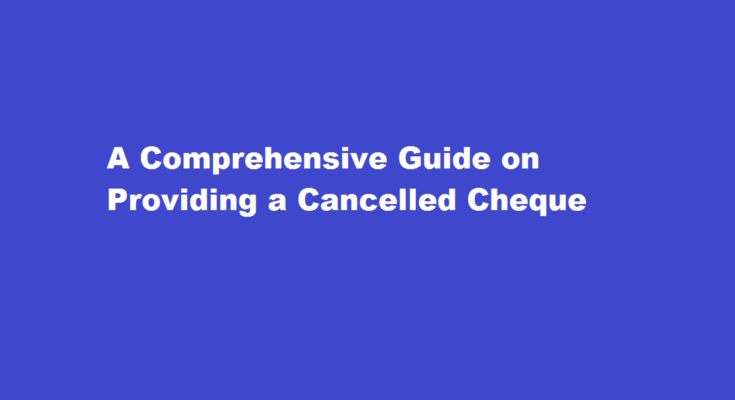Introduction
In the realm of banking transactions, a cancelled cheque holds significant importance. It serves as a crucial document for verifying your bank account details and facilitating various financial processes. This article aims to provide you with a comprehensive guide on what a cancelled cheque is, its uses, and how to provide one. Whether you’re applying for a loan, setting up an automatic payment, or seeking direct deposit, understanding the process of providing a cancelled cheque will prove invaluable.
Understanding a Cancelled Cheque
Before diving into the process, let’s clarify what exactly a cancelled cheque is. A cancelled cheque is a check that has been voided by drawing two diagonal lines across the front of the cheque, marking it as unusable for monetary transactions. The purpose of cancelling a cheque is to render it void and eliminate the possibility of misuse or unauthorised transactions. However, despite being cancelled, a cheque still holds crucial information, such as the account holder’s name, account number, and bank’s name and address, which can be used for verification purposes.
Uses of a Cancelled Cheque
A cancelled cheque serves multiple purposes in the realm of financial transactions. Let’s explore some common scenarios where you may be required to provide a cancelled cheque
1. Bank Account Verification Many organisations, such as employers, government agencies, and financial institutions, may request a cancelled cheque as proof of your bank account details, including account number and bank branch, for setting up direct deposits or electronic fund transfers.
2. Loan Applications Lenders often require a cancelled cheque to validate the applicant’s bank account information before disbursing the loan amount. It ensures that the funds are transferred to the correct account.
3. Automatic Bill Payments When opting for automatic bill payments, service providers may ask for a cancelled cheque to ensure accurate withdrawal of funds from your bank account.
Providing a Cancelled Cheque
Now, let’s delve into the process of providing a cancelled cheque effectively
1. Obtain a Cheque Begin by acquiring a personal chequebook from your bank if you don’t already have one. Ensure that your chequebook includes personalization with your name, account number, and other relevant details.
2. Fill in the Details Using a pen, carefully fill out the necessary information, such as the recipient’s name, date, amount, and purpose, as you would for a regular cheque.
3. Cancel the Cheque Take a dark-coloured pen or marker and draw two diagonal lines across the front of the cheque, from the top left corner to the bottom right corner and vice versa. Ensure the lines are thick and clear, making it easily distinguishable as a cancelled cheque.
4. Preserve the Cheque It’s essential to keep a copy of the cancelled cheque for your records before submitting it. You can either take a clear photograph or make a photocopy of the cheque. This will help you retain the necessary information and ensure a smooth process in case you need to provide it again in the future.
5. Submitting the Cancelled Cheque Depending on the requirement, you may need to physically submit the cancelled cheque or provide a scanned copy. Double-check the instructions provided by the recipient to ensure you comply with their preferred method.
FREQUENTLY ASKED QUESTIONS
Is it safe to give a Cancelled cheque?
It shows your bank details clearly. These details include the bank’s name, your name, and your account number. The cheque also has a unique cheque number. A cancelled cheque is a safe way to share your banking information.
Is a signature required on a cancelled cheque?
You are not required to sign a cancelled cheque because it is merely proof and not a transaction. There is no need to sign or write anything on a cancelled cheque, including your signature, amount, payee’s name, or any other information.
Conclusion
Providing a cancelled cheque is a straightforward process that can have a significant impact on various financial transactions. By following the steps outlined in this guide, you can ensure that you provide accurate and valid information to the requesting party. Remember to keep a copy of the cancelled cheque for your records, as it may come in handy in future transactions.
Read Also : Granting Camera Access A User’s Guide to Privacy and Permissions



